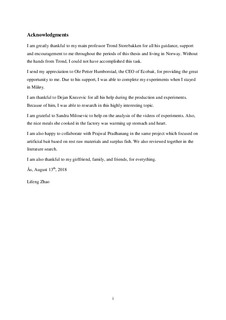| dc.description.abstract | Atlantic cod is one of the main fish specifies for commercial fishery in Norway which largely utilizes the longline technique for fishing. This method requires baits as an important element. Ideal longline baits should be strong, palatable and attractive to cod. This experiment aims to attain the ideal properties of bait by optimization of the extrusion and coating process under correct diet formulations. Five diets (diet - A, B, C, D, and E) were extruded, and each of them was coated with four variations of coating solutions (coating - A, B, C, D) to produce a 5x4 matrix of 20 different samples. Samples were either cooled (coated-cooled) or dried (coated-dried) at 10℃ for the strengthening of the baits. All samples were subjected to strength test which showed coated-dried baits stronger than coated-cooled baits. Thus, dried baits were further analyzed for moisture and water activity analysis along with their feeding trials to cod in tanks. The strength-test results among the coating-solutions within diets showed higher strength for coating B and D (9% gelatin) than A and C (5% gelatin) regardless of the difference in water types used (i.e., fresh or seawater). Among the diets, diet B and C showed the highest strength than diet A, D and E. Moisture analysis among coating-solutions showed freshwater samples (coating A and B) with significantly higher moisture content than seawater samples (coating C and D) and 5% gelatin samples (coating A and C) with higher moisture than 9% gelatin (coating B and D). This represents coating A (5% gelatin + freshwater) having the highest water content in all diets. Among diets, diet D and E contain lower moisture than rest diets. Water activity analysis showed a small difference among all samples ranging from 0.789 to 0.913. Even though statistical analysis showed a significant difference between the samples; they did not follow the explainable trend. Feeding trials with the coating-solutions within the diets showed the highest preference for coating D (9% gelatin + seawater). Among five diets, diet D showed the highest preference for cod than the rest of the diets. The ideal baits properties of having high strength for longline hooks and attractive to cod did not find in the same diet which calls for further studies in this field. | nb_NO |

